The Morgan Library & Museum
October 12, 2018 through January 6, 2019
National Gallery of Art, Washington,
Early 2019.
The
dramatic canvases of Jacopo Tintoretto (1518/1519 – 1594) , with their muscular,
expressive bodies, are some of the most distinctive of the Italian Renaissance.
His drawings , however, have received less atte ntion as a distinctive
category in his oeuvre . Opening October 12, Drawing in Tintoretto’s Venice will
be the first exhibition since 1956 to focus on the drawing practice of this
major artist . It will offer a new perspective on Tintoretto’s evolut on as a
draftsman, his individuality as an artist, and his influence on a generation of
painters in northern Italy.
Organized to mark the five - hundredth anniversary
of the artist’s birth, this exhibition brings together more than seventy
drawings and a small group of related paintings . It places Tintoretto’s
distinctive figure drawings alongside works by contemporaries such as Titian,
Veronese, and Bassano , as well as by artists — Domenico Tintoretto, Palma
Giovane, and others — working in Venice during the late sixteenth century, whose
drawing style was influenced by Tintoretto’s.
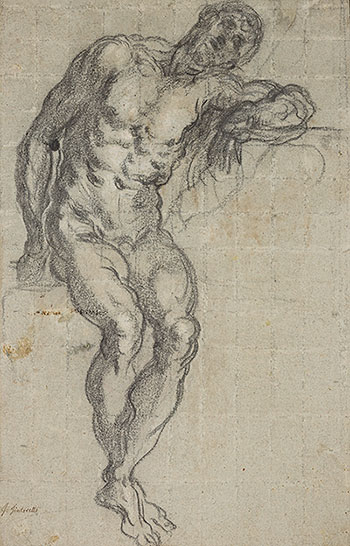
Tintoretto (1518/19 - 1594), Seated Male Nude , ca. 1549. Black and white chalk, squared, on blue paper. Musée du Louvre, Paris, inv. 5385. © RMN - Grand Palais / Art Resource, NY
The exhibition also features a particularly engaging group of drawings that have recently been proposed as the work of the young El Greco during his time in Italy. When the exhibition travels to the NGA in March 2019, it will be shown with Tintoretto: Artist of Renaissance Venice , a major retrospective focusing on his paintings.
The Exhibition Seven sections explore the career and legacy of Tintoretto. Born the son of a fabric dyer ( tintore in Italian ) from whose profession the young artist derived his nickname, the ar tist rose to prominence in the 1540s. By the time of his death in May 1594, he was the pre - eminent artist in Venice, responsible for vast pictorial cy cles in the Palazzo Ducale and the Scuola Grande di San Rocco, as well as paintings found throughout the churches and palaces of Venice. Even during his lifetime, he was thought of as an impetuous genius, an artist who worked hastily, without careful design or consideration. Yet although Tintoretto was never an academic draftsman akin to his Florentine contemporaries, over the course of his career he forged his own distinctive style of drawing and his own way of using them . As Tintoretto’s fame grew, his expanding workload required more assistants, and his drawing practice evolved. In training those assistants he influenced a generation of artists in northern Italy.
The Venetian School of Drawing and Tintoretto’s Early Works
Since the sixteenth century, writers have often noted a distinction between the supposedly more formalized and intellectual process of drawing in central Italy and the more personal, experimental Venetian approach. Venetian artists indeed adopted a broad range of techniques, media, and methods of drawing, including pen and ink, black and white chalk on blue paper, colored chalks, and b rush drawings. Tintoretto’s experimental manner evolved in the context of these rich, diverse means of design.

Titian, the leading artist of his time, remained a powerful influence through works such as Embracing Couple , which might be considered the quintessential Venetian drawing: it is loose and impressionistic yet also a powerful study of light and shadow falling across bodies twisting through space.
Tintoretto was equally fascinated by the works of artists like Pordenone and Schiavone, who presented alternate artistic paths. By 1537 or 1538, Tintoretto was an indepen dent master. While many of Tintoretto’s drawings have been lost, from those that remain we can trace his evolution from an early experimental mode of drawing akin to Schiavone’s, to an increasing attention on life study, and on to quicker, functional figure drawings intended to satisfy the practical needs of a busy painter. A drawing like his Venus and Vulcan highlights the various elements of Tintoretto’s early drawing style, with its energetic approach to design and bodies that are simultaneously muscular and lithe.
Highlights in Tintoretto’s Career , and the Evolution of His Drawing Practice
The watershed moment in Tintoretto’s career was the unveiling in 1548 of his
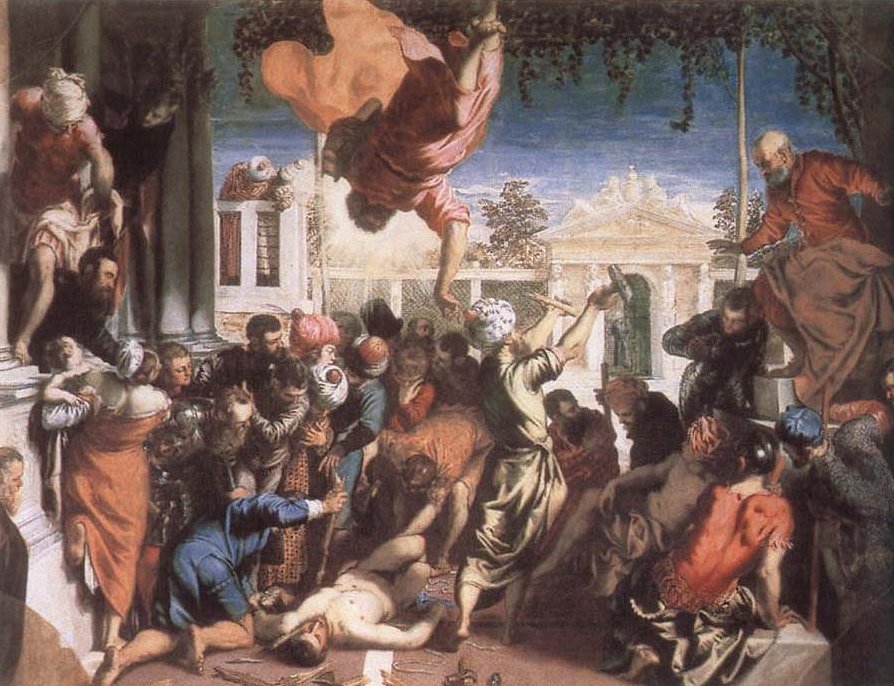
Miracle of the Slave , a work of a monumentality, drama, and richness unseen in his painting to that point. The confraternity of San Rocco then commissioned Tintoretto to take up the decoration of their church.
During the late 1550s, Tintoretto also painted two vast paintings for the church of the Madonna dell’Orto,



the Last Judgment

and Making of the Golden Calf.
These highlighted Tintoretto’s abilities and soon led to commissions at the Palazzo Ducale and the Scuola Grande di San Marco.
A few years later, Tintoretto began painting the Scuola di San Rocco, a project that would occupy him on and off for the rest of his career. Although there are no extant drawings directly related to the Miracle of the Slave the exhibition includes studies connected with each of these other projects.
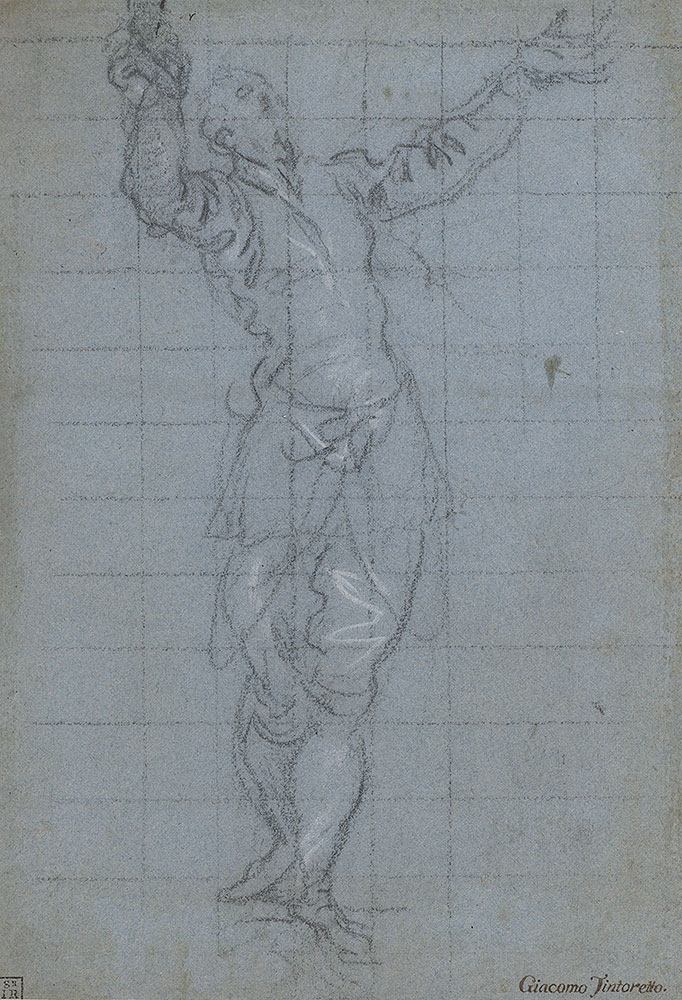
Tintoretto (1518/19 - 1594) , Study of a Man with Raised Arms , ca. 1562 – 66 , charcoal, heightened with white, on blue paper, squared for transfer , The British Museum, London . ©The Trustees of the British Museum
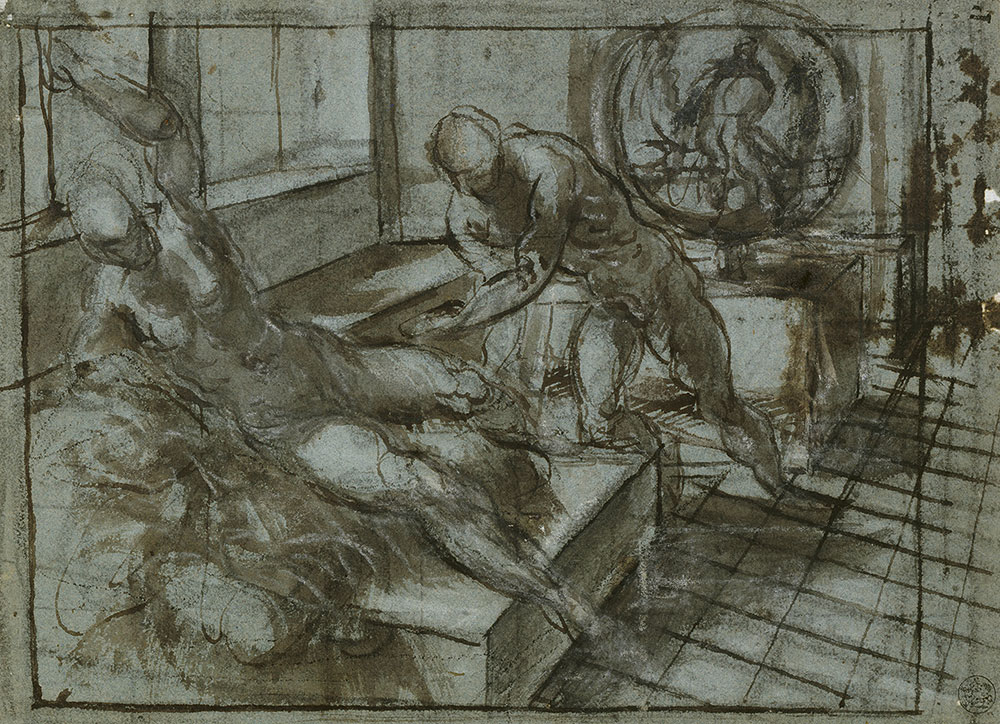
Tintoretto (1518/19 – 1594), Venus and Vulcan , ca. 1545, black chalk, pen and brown ink with brown and gray wash, bpk Bildagentur / Kupferstichkabinett, Staatliche Museen zu Berlin / Art Resource, NY . Photography by Jorg P. Anders
The most familiar of Tintoretto’s drawings are the many studies after Michelangelo’s Samson and the Philistines and his sculptures in the Medici Chapel . A group of these studies is included in the exhibition, along with a cast of the Samson on which they are based. Although traditionally believed to be Tintoretto’s own youthful studies, the exhibition argues that these sculpture drawings are exercises that he used in his workshop to teach his assistants how to convey drama , meaning , and sculptural presence of the human form.
In later years, Tintoretto’s workload increased to such a degree that his paintings were designed by him but executed by the workshop. His later figure drawings tend to be more simplified and abstracted than his earlier studies of live models, and they frequently adopt exaggerated musculature that was perhaps i ntended to emphasize form for the workshop assis tants executing the paintings.
Tintoretto’s Influence on the Next Generation
Tintoretto’s son Domenico (1560 – 1635) was trained in the family workshop in the 1570s and eventually became his father’s primary assistant and artistic heir. In his early years, he demonstrated a talent for naturalistic observati on in both drawing and painting and was a notable portraitist.
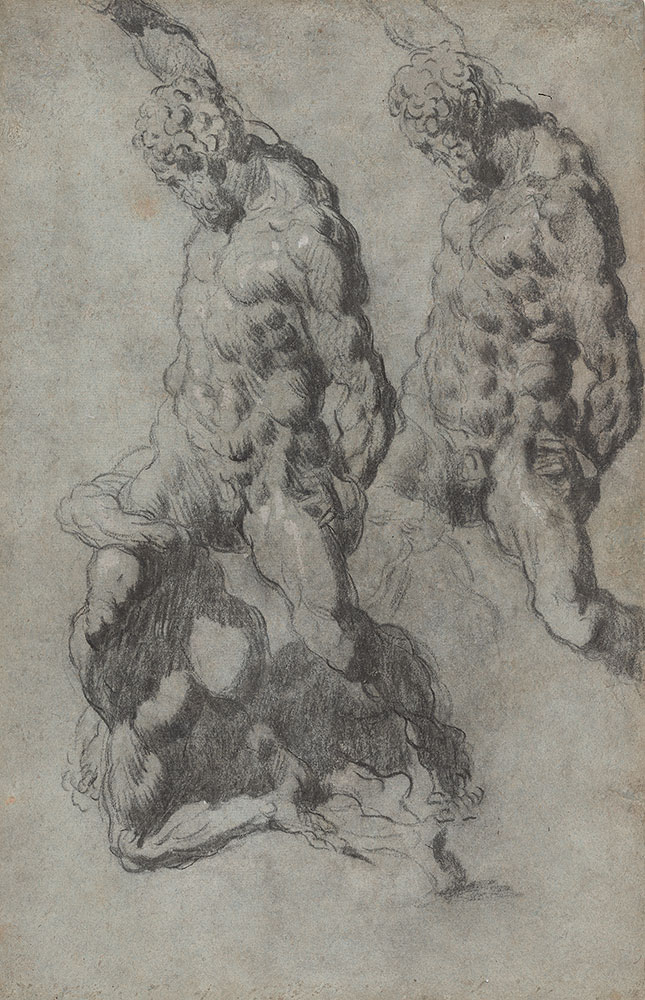
Domenico Tintoretto (?) and Workshop (1518/19 - 1594), Study of Michelangelo’s Samson and the Philistines (recto and verso), ca. 1560 – 70, charcoal and black chalk with white opaque watercolor on blue paper, The Morgan Library & Museum, Thaw Collection, 2005.234. Photography by Janny Chiu.
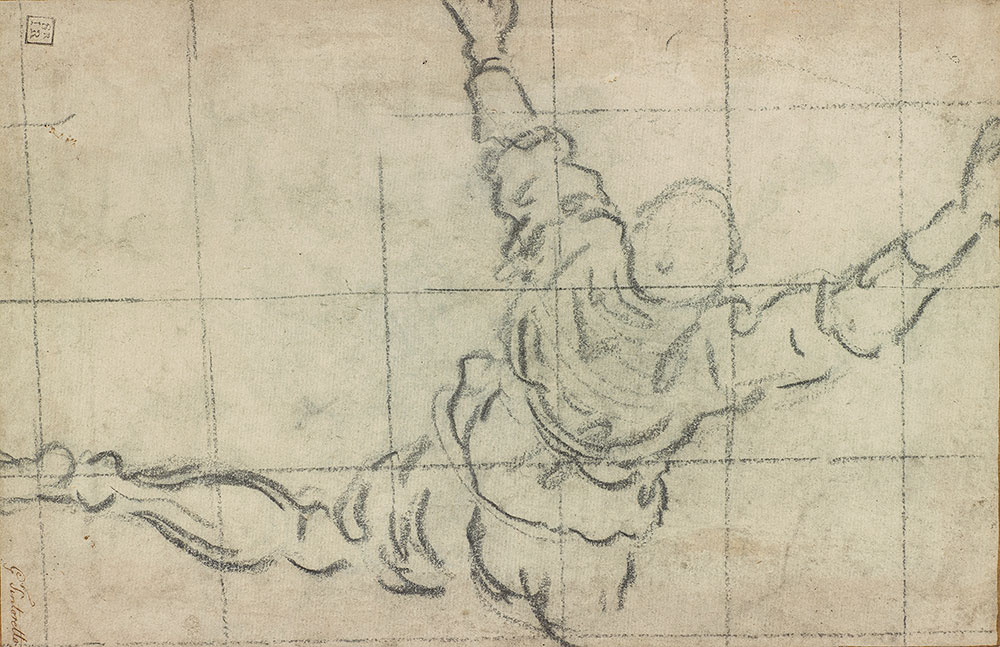
Tintoretto (1518/19 - 1594), Study for a Man Climbing into a Boat (recto), 1578 – 79, charcoal, squared in charcoal. The Morgan Library & Museum. Gift of J.P. Morgan, Jr. The Morgan Library & Museum, IV, 76. Photography by Graham S. Haber, 2012.
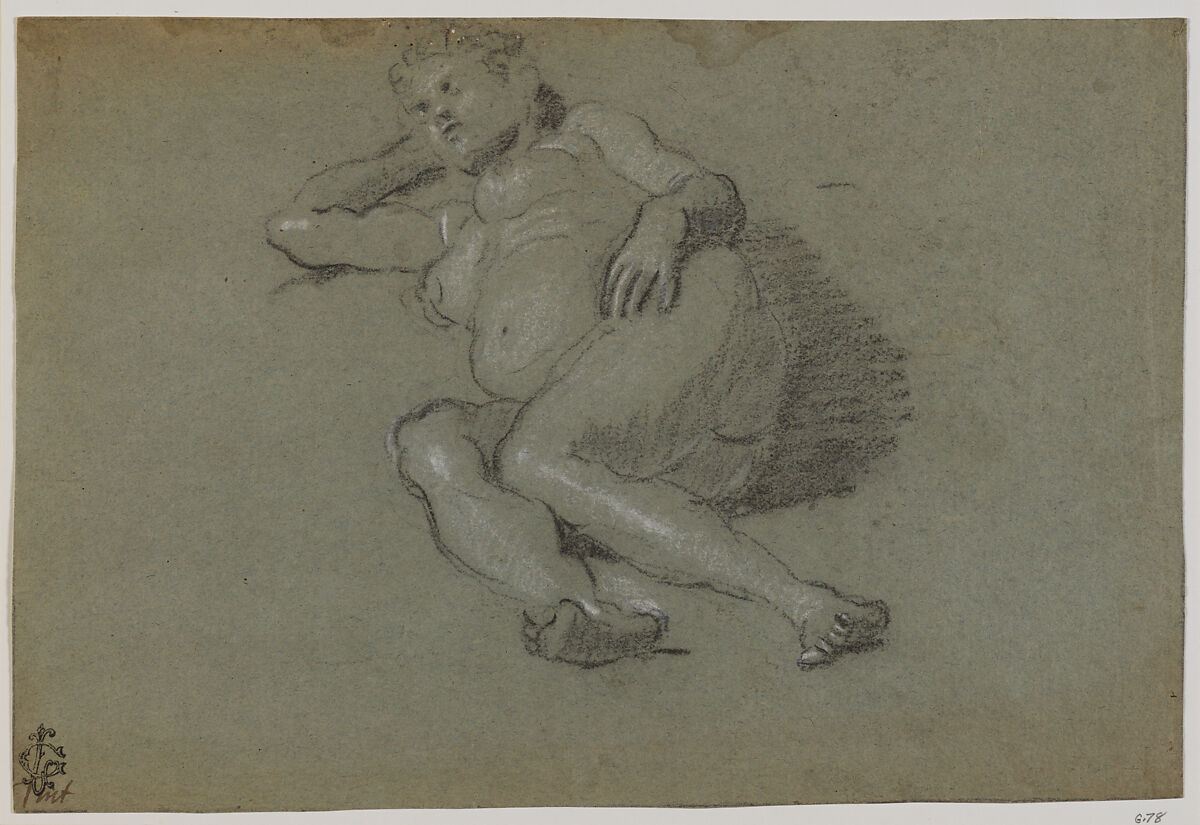
was arguably at his best when making studies of a model, such as his remarkable series of drawings after a female nude. However, later in his career and particularly after the death of his father, Domenico abandoned his interest in anatomical structure and three - dimensional space that always characterized his father ’s work , although he essentially continued Jacopo’s working methods .
Some of the most intriguing drawings in the show are the early works of Domenikos Theotokopoulos, El Greco, (ca. 1541 – 1614) done during his years in Italy. They have the same heightened emotion seen in El Greco’s paintings, with dramatic lightin g depict ing crowds of figures with their heads clustered together. Long considered the work of an unknown artist in Tintoretto’s circle, these drawings are comparable to the few later drawings believed to be by El Greco , and several also include his characteristic handwriting.
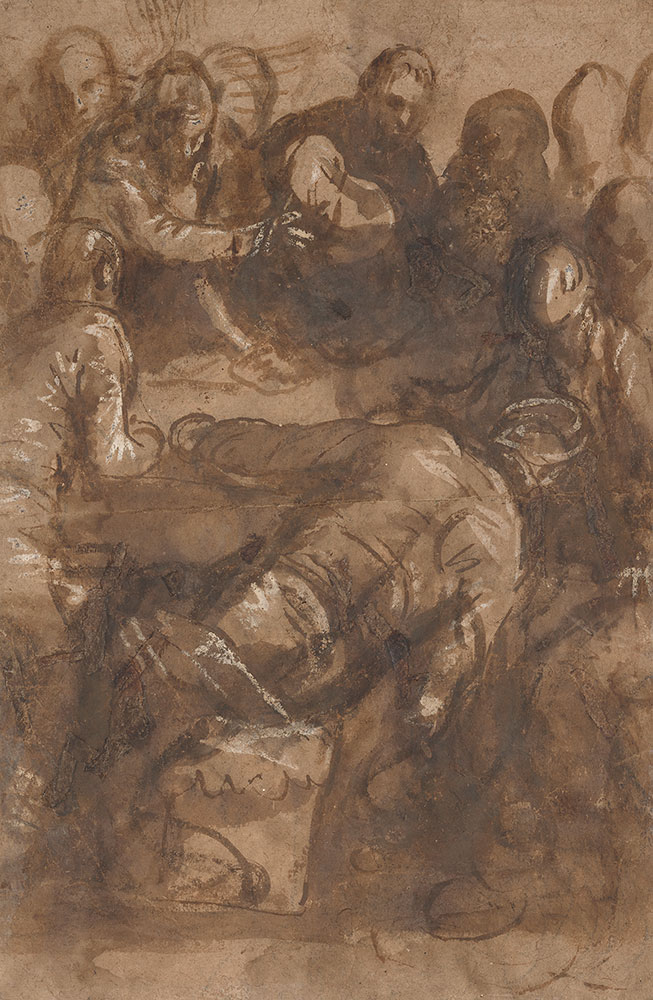
While the work of a distinctive artist, a drawing such as the Last Supper (ca. 1575 ) reveals a compositional debt to Tintoretto and evokes an emotional intensity similar to Tintoretto’s Christ Mocked (also in the exhibition).
In many ways, Jacopo Palma (ca. 1548 – 1628) became Tintoretto’s truest artistic heir. The son of the minor painter Antonio Palma, he received early training in his father’s workshop in Venice and traveled to Pesaro and Rome for various projects before retur ning to Venice. During the campaign to redecorate the Palazzo Ducale after the fire of 1577, Palma was closely associated with Tintoretto and his workshop, and after Tintoretto’s death, it was Palma rather than Domenico Tintoretto who became the leading pa inter in Venice.

Tintoretto (1518/19 - 1594), Seated Male Nude , ca. 1549. Black and white chalk, squared, on blue paper. Musée du Louvre, Paris, inv. 5385. © RMN - Grand Palais / Art Resource, NY
The exhibition also features a particularly engaging group of drawings that have recently been proposed as the work of the young El Greco during his time in Italy. When the exhibition travels to the NGA in March 2019, it will be shown with Tintoretto: Artist of Renaissance Venice , a major retrospective focusing on his paintings.
The Exhibition Seven sections explore the career and legacy of Tintoretto. Born the son of a fabric dyer ( tintore in Italian ) from whose profession the young artist derived his nickname, the ar tist rose to prominence in the 1540s. By the time of his death in May 1594, he was the pre - eminent artist in Venice, responsible for vast pictorial cy cles in the Palazzo Ducale and the Scuola Grande di San Rocco, as well as paintings found throughout the churches and palaces of Venice. Even during his lifetime, he was thought of as an impetuous genius, an artist who worked hastily, without careful design or consideration. Yet although Tintoretto was never an academic draftsman akin to his Florentine contemporaries, over the course of his career he forged his own distinctive style of drawing and his own way of using them . As Tintoretto’s fame grew, his expanding workload required more assistants, and his drawing practice evolved. In training those assistants he influenced a generation of artists in northern Italy.
The Venetian School of Drawing and Tintoretto’s Early Works
Since the sixteenth century, writers have often noted a distinction between the supposedly more formalized and intellectual process of drawing in central Italy and the more personal, experimental Venetian approach. Venetian artists indeed adopted a broad range of techniques, media, and methods of drawing, including pen and ink, black and white chalk on blue paper, colored chalks, and b rush drawings. Tintoretto’s experimental manner evolved in the context of these rich, diverse means of design.

Titian (1488 - 1576), Embracing Couple , ca. 1568 – 70, charcoal and black and white chalk on faded blue paper. The Syndics of the Fitzwilliam Museum, University of Cambridge. © The Fitzwilliam Museum, Cambridge
Titian, the leading artist of his time, remained a powerful influence through works such as Embracing Couple , which might be considered the quintessential Venetian drawing: it is loose and impressionistic yet also a powerful study of light and shadow falling across bodies twisting through space.
Tintoretto was equally fascinated by the works of artists like Pordenone and Schiavone, who presented alternate artistic paths. By 1537 or 1538, Tintoretto was an indepen dent master. While many of Tintoretto’s drawings have been lost, from those that remain we can trace his evolution from an early experimental mode of drawing akin to Schiavone’s, to an increasing attention on life study, and on to quicker, functional figure drawings intended to satisfy the practical needs of a busy painter. A drawing like his Venus and Vulcan highlights the various elements of Tintoretto’s early drawing style, with its energetic approach to design and bodies that are simultaneously muscular and lithe.
Highlights in Tintoretto’s Career , and the Evolution of His Drawing Practice
The watershed moment in Tintoretto’s career was the unveiling in 1548 of his

Miracle of the Slave , a work of a monumentality, drama, and richness unseen in his painting to that point. The confraternity of San Rocco then commissioned Tintoretto to take up the decoration of their church.
During the late 1550s, Tintoretto also painted two vast paintings for the church of the Madonna dell’Orto,

the Last Judgment

and Making of the Golden Calf.
These highlighted Tintoretto’s abilities and soon led to commissions at the Palazzo Ducale and the Scuola Grande di San Marco.
A few years later, Tintoretto began painting the Scuola di San Rocco, a project that would occupy him on and off for the rest of his career. Although there are no extant drawings directly related to the Miracle of the Slave the exhibition includes studies connected with each of these other projects.

Tintoretto (1518/19 - 1594) , Study of a Man with Raised Arms , ca. 1562 – 66 , charcoal, heightened with white, on blue paper, squared for transfer , The British Museum, London . ©The Trustees of the British Museum

Tintoretto (1518/19 – 1594), Venus and Vulcan , ca. 1545, black chalk, pen and brown ink with brown and gray wash, bpk Bildagentur / Kupferstichkabinett, Staatliche Museen zu Berlin / Art Resource, NY . Photography by Jorg P. Anders
The most familiar of Tintoretto’s drawings are the many studies after Michelangelo’s Samson and the Philistines and his sculptures in the Medici Chapel . A group of these studies is included in the exhibition, along with a cast of the Samson on which they are based. Although traditionally believed to be Tintoretto’s own youthful studies, the exhibition argues that these sculpture drawings are exercises that he used in his workshop to teach his assistants how to convey drama , meaning , and sculptural presence of the human form.
In later years, Tintoretto’s workload increased to such a degree that his paintings were designed by him but executed by the workshop. His later figure drawings tend to be more simplified and abstracted than his earlier studies of live models, and they frequently adopt exaggerated musculature that was perhaps i ntended to emphasize form for the workshop assis tants executing the paintings.
Tintoretto’s Influence on the Next Generation
Tintoretto’s son Domenico (1560 – 1635) was trained in the family workshop in the 1570s and eventually became his father’s primary assistant and artistic heir. In his early years, he demonstrated a talent for naturalistic observati on in both drawing and painting and was a notable portraitist.

Domenico Tintoretto (?) and Workshop (1518/19 - 1594), Study of Michelangelo’s Samson and the Philistines (recto and verso), ca. 1560 – 70, charcoal and black chalk with white opaque watercolor on blue paper, The Morgan Library & Museum, Thaw Collection, 2005.234. Photography by Janny Chiu.

Tintoretto (1518/19 - 1594), Study for a Man Climbing into a Boat (recto), 1578 – 79, charcoal, squared in charcoal. The Morgan Library & Museum. Gift of J.P. Morgan, Jr. The Morgan Library & Museum, IV, 76. Photography by Graham S. Haber, 2012.
Domenico Tintoretto (1560 - 1635), Reclining Female Nude , ca. 1590, black and white chalk on blue paper. © The Metropolitan Museum of Art. Image source: Art Resource, NY.
was arguably at his best when making studies of a model, such as his remarkable series of drawings after a female nude. However, later in his career and particularly after the death of his father, Domenico abandoned his interest in anatomical structure and three - dimensional space that always characterized his father ’s work , although he essentially continued Jacopo’s working methods .
Some of the most intriguing drawings in the show are the early works of Domenikos Theotokopoulos, El Greco, (ca. 1541 – 1614) done during his years in Italy. They have the same heightened emotion seen in El Greco’s paintings, with dramatic lightin g depict ing crowds of figures with their heads clustered together. Long considered the work of an unknown artist in Tintoretto’s circle, these drawings are comparable to the few later drawings believed to be by El Greco , and several also include his characteristic handwriting.

Attributed to El Greco (ca. 1541 - 1614), Last Supper , ca. 1575, brown wash with white opaque watercolor, over black chalk, on light brown paper. The Morgan Library & Museum, gift of János Scholz, 1981.96. Photography by Janny Chiu, 2018.
While the work of a distinctive artist, a drawing such as the Last Supper (ca. 1575 ) reveals a compositional debt to Tintoretto and evokes an emotional intensity similar to Tintoretto’s Christ Mocked (also in the exhibition).
In many ways, Jacopo Palma (ca. 1548 – 1628) became Tintoretto’s truest artistic heir. The son of the minor painter Antonio Palma, he received early training in his father’s workshop in Venice and traveled to Pesaro and Rome for various projects before retur ning to Venice. During the campaign to redecorate the Palazzo Ducale after the fire of 1577, Palma was closely associated with Tintoretto and his workshop, and after Tintoretto’s death, it was Palma rather than Domenico Tintoretto who became the leading pa inter in Venice.
Palma’s drawings take us back not only to the chalk drawings of Titian and
Tintoretto but also to the pen drawings of Veronese and the compositional
studies of Schiavone and the Tintoretto family.
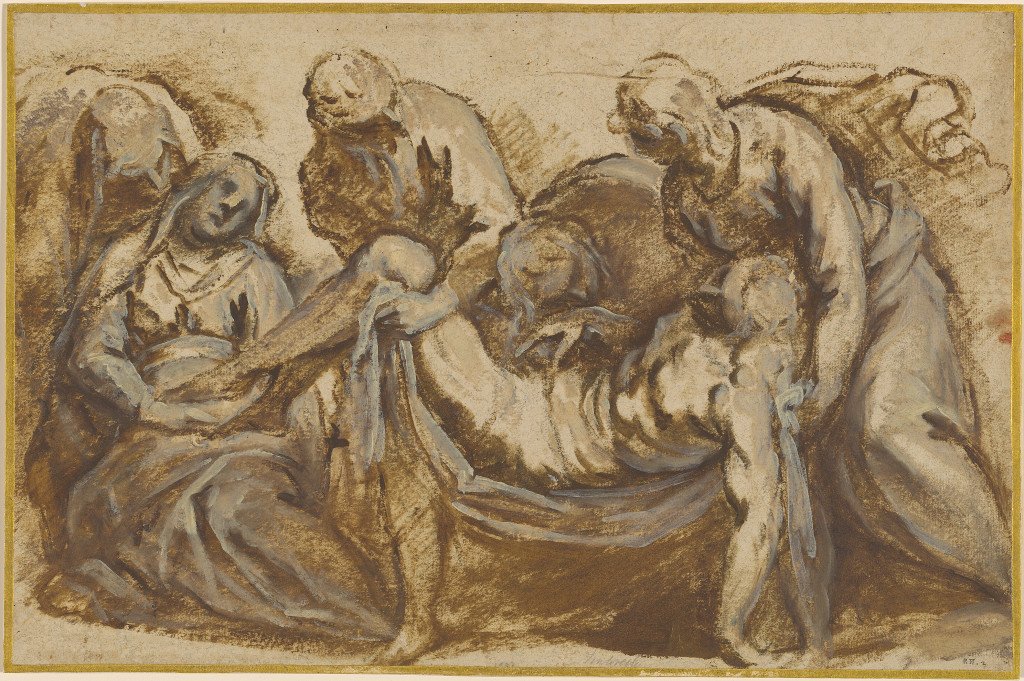
Palma Giovane (1544 - 1628), Christ Carried to the Tomb , ca. 1610, brush and brown and white oil paint over black chalk on oatmeal paper. National Gallery of Art, Washington, Wolfgang Ratjen Collection, Purchased as the Gift of Helen Porter and James T. Dyke, 2007. Courtesy National Gallery of Art, Washington.
Palma’s Christ Carried to the Tomb (ca. 1610), for example, captures the
spiritual intensity of Titian’s late devotional painting as well as the urgent energy
of Tintoretto’s, and is drawn in a painterly technique parallel akin to that of
Schiavone or Domenico Tintoretto. In Palma’s works, we can see a summary of the
distinct ive local traditions of drawing in Tintoretto’s Venice.
Publication

Publication
Drawing in Tintoretto’s Venice offers a
complete overview of Tintoretto as a draftsman, in which all of the drawings
in the exhibition are discussed and illustrated . A checklist of the exhibition
is also included in the volume. Author: John Marciari. Publisher: Paul
Holberton Publishing, London. 240 pages, 175 colour illustrations.